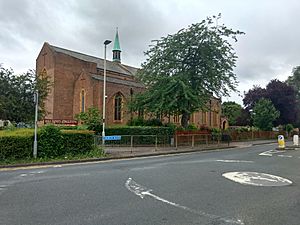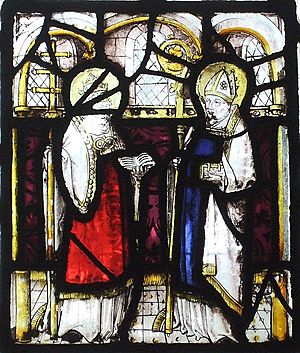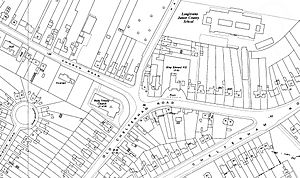Holy Trinity Church, Longlevens facts for kids
Holy Trinity Church is a special Church of England parish church located in Longlevens, Gloucester. It was designed by an architect named Harold Stratton Davis. The church was built between 1933 and 1934. Its design looks like churches from the 1400s, with a style called Perpendicular Gothic. Inside, you can see beautiful stained glass windows. These windows are very old, some from Germany and the Netherlands. They were moved here from another church, St Luke's, after it was taken down in 1934.
History and Design
Building the Church
The church was designed by Harold Stratton Davis. His father had worked as a church leader in Longlevens. The building was constructed from 1933 to 1934. It was made to look like churches from the 1400s. This style is known as Perpendicular Gothic.
The builders used materials from the local area. They used red bricks from Coleford. Stone from Guiting was also used for decorations. The roof is covered with slate from Delabole in Cornwall. A local metalworker, Alfred Bucknell, made the iron parts. These included the special rainwater pipes. The church's font, which is a basin for baptisms, was a gift. It came from the freemasons of Gloucester.
Replacing the Old Church
Holy Trinity Church was officially opened on March 31, 1934. It took the place of an older church. That church was built in the 1800s. It was made of corrugated iron. People in the area called it the "tin tabernacle". It was located very close by.
Special Features and Art
Holy Trinity Church is a "Grade II listed" building. This means it is an important historical building. Historic England says it's special because its 1930s design is still mostly the same. Many of its fittings were designed by the architect himself. They form a "remarkably complete set."
Most of the stained glass windows are not new to this church. Many of them are very old. Some are from the 1400s to the 1700s. They came from Germany or the Netherlands. A man named Reverend Samuel Lysons gave them to the church. They used to be in the main window of the Church of St Luke. That church was in High Orchard, Gloucester. It was taken down in 1934. The stained glass window in the chapel's east side was made later. It was created by Molly Meager in 1989. You can also find two plaques inside. These are memorials for soldiers from the wars.




